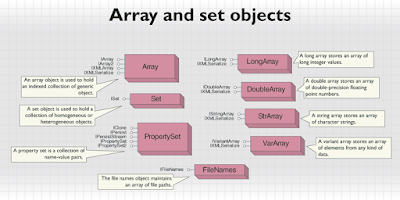Array in Java
Alternatively you can create arrays as follows:
dataType[] arrayRefVar = {value0, value1, ..., value n};
Array
indices are 0-based; that is, they start from 0 to arrayRefVar.length-1.
Example:
Following statement declares an array variable, myList,
creates an array of 10 elements of double type and assigns its reference to
myList:
double[] myList = new double[10];
Following picture represents array myList. Here, myList
holds ten double values and the indices are from 0 to 9.
Processing Arrays:
When processing array elements, we often use either for loop
or foreach loop because all of the elements in an array are of the same type
and
the size of the array is known.
Example:
Here is a complete example of showing how to create,
initialize and process arrays:
public class TestArray {
public static void
main(String[] args) {
double[] myList
= {1.9, 2.9, 3.4, 3.5};
// Print all the
array elements
for (int i = 0;
i < myList.length; i++) {
System.out.println(myList[i] + " ");
}
// Summing all
elements
double total =
0;
for (int i = 0;
i < myList.length; i++) {
total +=
myList[i];
}
System.out.println("Total is " + total);
// Finding the
largest element
double max =
myList[0];
for (int i = 1;
i < myList.length; i++) {
if (myList[i]
> max) max = myList[i];
}
System.out.println("Max is " + max);
}
}
Result:
This would produce the following result:
1.9
2.9
3.4
3.5
Total is 11.7
Max is 3.5
(Enhanced for loop, which enables you to traverse the complete array
sequentially without using an index variable.)
Passing Arrays to Methods:
Just as you can pass primitive type values to methods, you
can also pass arrays to methods. For example, the following method displays the
elements in an int array:
public static void printArray(int[] array) {
for (int i = 0; i
< array.length; i++) {
System.out.print(array[i] + " ");
}
}
You can invoke it by passing an array.
For example, the following statement invokes the printArray method to display 3, 1, 2, 6, 4, and 2:
For example, the following statement invokes the printArray method to display 3, 1, 2, 6, 4, and 2:
printArray(new int[]{3, 1, 2, 6, 4, 2});
Returning an Array from a Method:
A method may also return an array. For example, the method
shown below returns an array that is the reversal of another array:
public static int[] reverse(int[] list) {
int[] result = new
int[list.length];
for (int i = 0, j =
result.length - 1; i < list.length; i++, j--) {
result[j] =
list[i];
}
return result;
}
The Arrays Class:
The java.util.Arrays class contains various static methods
for sorting and searching arrays, comparing arrays, and filling array elements.
These methods are overloaded for all primitive types
These methods are overloaded for all primitive types
1-public
static int binarySearch(Object[] a, Object key)
Searches the specified array of Object ( Byte, Int , double, etc.) for the specified value using the binary search algorithm. The array must be
Searches the specified array of Object ( Byte, Int , double, etc.) for the specified value using the binary search algorithm. The array must be
sorted prior to making this call. This returns index of the
search key, if it is contained in the list; otherwise, (-(insertion point + 1).
2- public
static boolean equals(long[] a, long[] a2)
Returns true if the two specified arrays of longs are equal
to one another. Two arrays are considered equal if both arrays contain the same
number of elements, and all corresponding pairs of elements
in the two arrays are equal. This returns true if the two arrays are equal.
Same
method could be used by all other primitive data types (Byte,
short, Int, etc.)
3- public static void fill(int[] a, int val)
Assigns the specified int value to each element of the
specified array of ints. Same method could be used by all other primitive data
types
(Byte, short, Int etc.)
4-public
static void sort(Object[] a)
Sorts the specified array of objects into ascending order,
according to the natural ordering of its elements. Same method could be used by
all
other primitive data types ( Byte, short, Int, etc.)





Comments
Post a Comment